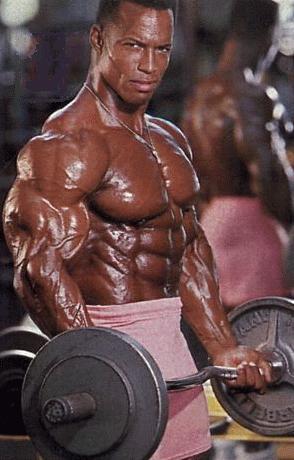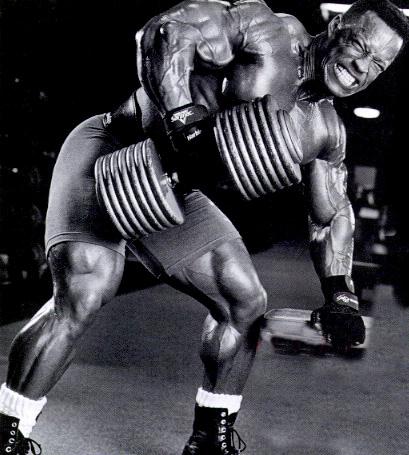Shawn Ray's Guide to Training This section was originally printed in the April 2000 issue of Flex Magazine. The following is the article in its entirety. This section was originally printed in the April 2000 issue of Flex Magazine. The following is the article in its entirety.
Shock Treatment:Five shocking principles for outrageous growthWhen you first start training, you make phenomenal gains. Your hitherto untrained body is so unused to the stresses of weight training that it is forced to respond with a rapid increase in muscle size and strength. That's the upside for the beginner. Eventually, however, your body adapts to the level of training stress you are exposing it to; your progress begins to slow and perhaps even stop. This syndrome is compounded by the fact that most of you who have the determination to go to the gym four or five times a week also like to have a clear-cut routine when you get there. You religiously follow a rigid six- or seven-day split--the same exercises, in the same order, using the same weights and reps. Well, guess what? That's the best way to make sure you continue to look the same. Once you've hit a plateau, you won't make progress unless you change your approach. Your training needs to evolve if you want your body to follow suit.
That's what my style of training--I call it "shock treatment"--is all about. It allows you to constantly make improvements in your physique by throwing something new at your body every time you go to the gym. Your body never has the chance to adapt under I follow this philosophy every time I walk into a gym. This is a thinking man's program, not some cookie-cutter routine that spells out how many exercises, sets and reps you need to perform. It's up to you to take the principles I explain and apply them in designing a training regimen that suits your needs. If you adopt this philosophy with total dedication from day one, you can build and strengthen your body exactly the way you want to. This is an exciting approach because you're doing something different at every training session, and the variety keeps your internal fire burning. You never know when that extra pump or max rep will hit if you don't challenge your training by mixing things up and shocking your body. Push, pull, stretch, squeeze--it's all the same, from beginner to advanced. In the end, you control your bodybuilding destiny. The principles I discuss should be applied to every bodypart, but I've simplified matters by using chest as an example of how to integrate these principles into your own bodypart split.
|

#1 USE DIFFERENT EXERCISES EVERY WORKOUTIt's easy to use your favorite exercises as a crutch. I see some guys in the gym bench pressing every day. If you don't know much about bodybuilding and how muscles respond to training, it's probably easy to convince yourself that the best way to build massive pecs is to train them day in and day out using the same exercises. A much better way to get your chest to grow, though, is to attack it with a variety of exercises and incorporate sufficient rest and recovery into your training cycle. For example, if my chest routine consists of bench presses, incline dumbbell presses, dumbbell flyes and dips for one rotation, the next time I work chest, I change up the exercises so I'm doing incline bench presses, flat dumbbell presses, incline dumbbell flyes and dips. The third time, I might go back to bench presses followed by incline Hammer Strength presses, dumbbell flyes and cable crossovers.
The formula is that there is no formula. I change all my exercises every time I go to the gym, for every bodypart. Not only does the variety keep me growing, it keeps me focused on my goal. If you start every chest routine with bench presses, your goal subtly starts to shift from increasing your muscle mass to a comparison of how much weight and how many reps you can perform. That's a head game that will eventually derail your training--and your success--as a bodybuilder.
#2 CHANGE YOUR EXERCISE ORDERYou'll also notice that the guy who bench presses every time he goes to the gym also bench presses first. If he does any other chest exercise first, he won't be able to bench as much weight and his ego will suffer. One of the best ways to make gains in how much you bench press, though, is to place it further back in your routine. Too many beginning and intermediate bodybuilders buy wholeheartedly into the concept that you have to start with mass building exercises, then work in detail and defining exercises afterward. Followed exclusively, however, that philosophy ignores a whole host of Weider Principles.
If, instead, you perform incline bench presses first, then flyes and finally bench presses, of course you won't be able to lift as much weight on the flat bench presses as you did when you placed them first. Your pectorals are already pre-exhausted--a Weider Principle--and you're Change your rotation every time out. I assure you that even though you might perform the same number of sets--and might even use less weight--you'll get a more trying workout and will feel like you've pushed your pecs to the limit. I apply this principle to all bodyparts, including legs. Sometimes, I even end my leg workouts with heavy squats, after I've done leg extensions, hack squats and lunges. |

#3 CHANGE REP AND WEIGHT SCHEMESAnother favorite technique for shocking my muscles is to vary rep and weight schemes from one training session to the next. For instance, if I train heavy during the first routine, I perform four sets of eight reps; then, next time, I choose four different exercises and work in the 12-15 rep range. Regardless of which rep scheme I choose, I still pyramid up in weight. I know ahead of time the target weight with which I can perform eight reps, reaching failure on the last. For the first of the four sets, I may use only 50-60% of that weifht for eight reps. I could easily pump out 12 to 15 reps at that lighter weight, but my goal for that day is to reach failure on the eighth rep of that fourth set, so I hold back a little on the first set. For the second set, for another eight reps, I use about 80% of my target weight. For my third set, I use 90-100% of my target weight, depending on how I feel that day. Then, for the fourth set, I use my target weight--and a spotter--to make sure I pump out eight quality reps. When I go into the gym again, I readjust my target weight so that I have a poundage with which I can successfully complete 12 to 15 reps--instead of eight. For instance, if I bench press in the higher-rep range, my target weight may be only 80% of what it would be on eight-rep days. Once my target weight is established, I use the same formula for pyramiding up in weight--about 50-60% for the first set of 12-15, 80% for the second, 90-100% for the third and 100% for the fourth set. |

#4 USE INTENSITY TECHNIQUESOne of the keys to increasing muscular gains is intensity. Here are a few techniques to increase the intensity of individual sets. These can be excellent tools for stimulating muscular growth--a couple of occasional more intense sets really shock the muscle. Don't overuse these techniques, though, because you run the risk of overtraining. Rest-pause:For my last three sets, I choose the maximum weight with which I can bench press 10 reps. I pump out a set of 10, rest for only 60 seconds, then do a second set. After that, I rest again for just a minute before completing my final set. Even though the weight doesn't change, the number of reps I'm able to complete in each set decreases because the target muscle can't fully recover before it is hit again. Drop sets:This is an excellent technique to use for going past failure. When I can't squeeze out another rep on my last set, I have a partner strip off about 40% of the weight, then I pump out as many reps as I can with the lighter weight. The drop set should be performed with as little rest as possible. As soon as the weight comes off, I'm good to go. Forced reps:This may be the most intense technique of all because it allows for no rest, and thus no recovery. When you reach failure, your partner assists as you comlete two or three more reps with perfrct form. The tendency at this point for most people is to squirm and try to use body English to lift the weight, but that only encourages injury and negates the benefits of the technique. You need to put 100% effort into using perfect form. Your spotter should give you only enough assistance to keep the bar moving slowly. Do everything else on your own. As a rule of thumb, use one intensity technique every other training session. In other words, during the first training session, you might use the rest-pause technique for incline bench presses. The next time you hit your chest, don't use an intensity technique. The third time you work your chest, you might use a drop set to finish up your bench presses.
#5 REVISE YOUR BODYPART SPLIT FREQUENTLY
For most people, falling into a rythm is the best way to set up a bodypart split. A lot fo guys like a seven-day split, because it fits a busy schedule. In a split like this, a The problem with this regularity is that the body accomodates to the training. After you finish training your chest, your body expects to train triceps. It's much better to shake it up. Follow a seven-ay split for the first cycle, then switch to a five-day split for the next cycle--training chest, shoulders and triceps on day one; back, biceps and abs on day two; rest on day three; train legs on day four; and do cardio on day five. For the third cycle, return to a seven-day split but match up your bodyparts differently. Train back and triceps on day one; quads and abs on day two, rest on day three; train chest and biceps on day four; shoulders, hamstrings and calves on day five; rest on day six; cardio and abs on day seven. The next cycle might be a six-day split. The point is that you shouldn't get too formulaic with the breakdown of your bodypart split. CONCLUSION If you keep weight training the way you always have, your body will eventually adapt and stop growing. The old bodybuilding adage is true: Every exercise works, but none of them work forever. Change things up, and you can shape, build and strengthen your body any way you desire. Give these five principles a try, and you will get the shock of your life. |